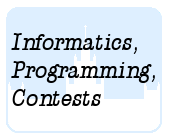Назад
 Начало Начало |
 Соревнования Соревнования |
| 2009 |
Подразделы
Другие разделы
| Задачи заочного тура личного первенства |
| Задачи заочного тура олимпиады по информатике |
| Задачи командного чемпионата |
| Областная олимпиада школьников по информатике |
Дата и время
08/01/2026 13:07:38
 Задачи очного тура личного первенства
Задачи очного тура личного первенства
A. Социальная сеть B. Counting Stars C. Cube Numbers D. Удаление букв E. Задача Тамерлана F. Генератор текста G. Складывание карты H. Под колпаком
 B. Counting Stars
B. Counting Stars
 Полный перебор
Полный переборОлимпиадные задачи на английском языке

| 26/09/2009 | Южно-Уральская открытая олимпиада, личное первенство (B) |
| 04/07/2013 | Лето 2013-4 (B) |
| 06/07/2018 | Лето 2018 - 6 (командные) (B) |
| 10/07/2020 | Лето 2020 - 5 (командное) (B) |
Ограничения: время – 500ms/1000ms, память – 64MiB Ввод: input.txt или стандартный ввод Вывод: output.txt или стандартный вывод 
Послать решение Blockly Посылки Темы Где Обсудить (0)

People generally don't care to give attention
to stars in a moonlit night. In most cases the attention goes towards the moon.
Sadly, you have to write a program now that can count the stars in the sky. For this problem a sky
is a two dimensional grid. Empty pixel is denoted by a '.' (ASCII value 46) and a non-empty pixel is
denoted by a '*' (ASCII value 42). As a star is a very small object so it cannot occupy
more than two adjacent pixels and in our sky two stars are never adjacent.
So three or more adjacent non-empty pixels can denote some larger objects like moon, comet, sun or UFOs
but they never represent a star. All the eight possible pixels around a pixel are adjacent to it.
In the figure below the black pixel at the center have eight adjacent pixels. Of them three pixels are non-empty.
*.. .** ..*
The input file contains at most 100 sets of inputs. The description of each set is given below:
Each set starts with two integer number `r` and `c` (`1\ ≤\ r,\ c\ ≤\ 100`), which indicates the
row and column number of the image to follow. Next `r` rows describe the sky as mentioned in the problem statement.
Input is terminated by a line containing two zeroes.
For each set of input produce one line of output. This line contains a decimal integer which
denotes the number of stars in the given sky.
Sample Input
5 5 ..... ....* ....* ...*. *.... 4 4 *... *... ...* *.*. 0 0
Sample Output
1 3

